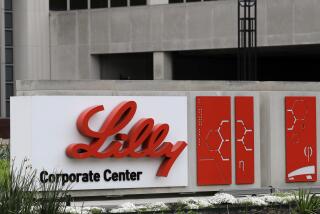FDA needs teeth to avert drug shortages
It didn’t used to be in Sandy Binder’s job description to be a drug sleuth.
As director of oncology community practices at UCLA, she didn’t have to spend two hours a day checking on the supply of crucial cancer drugs at her six clinics and dickering with suppliers to make sure her doctors could get their hands on what their patients needed, even if at a markup that tripled the normal cost.
Those were the old days, before the crisis of drug shortages in the United States spiraled out of control.
In 2004, the authoritative drug information service of the University of Utah recorded critical shortages for 58 drugs. Last year the number of new shortages reached 211, and this year reports of new shortages are arriving at a pace of more than one a day. So stand by for a record-breaking year, the service’s director, Erin Fox, told me.
We’re not talking about obscure medications or “orphan drugs,” which are those used to treat rare conditions. These are drugs used every day in operating rooms, by emergency crews and in cancer centers.
They include such widely used medications as leucovorin, a component of the gold standard for the treatment of colorectal cancer. Since about 2008, leucovorin has been in a “chronic, lingering, malignant, festering shortage” despite its importance, says Dwight Kloth, director of pharmacy at Fox Chase Cancer Center in Philadelphia.
Although there are multiple reasons for the explosion of drug shortages in this country, taken together they show that the structure of the pharmaceutical industry and its system of regulation are both deeply flawed. It doesn’t help that Congress, which often behaves like a subsidiary of the drug industry, hasn’t given the Food and Drug Administration decent tools to address the problem.
Those tools include information and clout. The FDA lacks both. Except in limited cases, drug companies aren’t required to issue advance notice of a decision to discontinue making a drug — not to the government, nor to hospitals, doctors, or patients.
Drug companies are required to give the FDA advance notice if they’re the sole supplier for a “medically necessary” drug. But the definition of “medically necessary” is murky; even widely used cancer drugs aren’t usually on the list, says Michael Link, a Stanford pediatrics professor and president-elect of the American Society Of Clinical Oncology.
What’s the legal penalty for violating the advance-notice rule? There isn’t one. The FDA can give the violator a stern talking-to, but after that, it’s shot its bolt. It can try to jawbone a company into continuing to manufacture an important product, but “if they refuse to reconsider, there’s nothing we can do,” says Valerie Jensen, head of the FDA’s drug shortage program.
Drug makers aren’t required to say why they’ve stopped making a drug. As Utah’s Fox reported in November at a conference on drug shortages, the reason most often cited — in 47% of the cases — is “unknown.” It’s known to the manufacturer, of course, just not to the public.
Almost all the critical shortages occur among generic products, which tells us that this has a lot to do with money. Profit margins for generics are a fraction of those for drugs still under patent. Consequently the cost-benefit calculus for a generics company getting bugged by the FDA over its manufacturing standards, say, are a lot different from those for a company with a blockbuster monopoly.
Genentech, for instance, has a huge economic incentive to keep turning out its cancer drug Avastin, for which colon cancer patients might pay more than $50,000 a year. Avastin racked up about $7.2 billion in sales in 2010, more than 17% of the pharmaceutical sales of Genentech’s parent, Roche.
By contrast, the maker of some aging product that sells for $1,500 per course of chemo might decide that the profit in the drug isn’t worth the hassle of upgrading its plant to meet FDA safety requirements.
Contributing to the crisis is a rapid consolidation of the generics industry over the last decade or so. When generics firms snarf each other up, the available sources for individual drugs shrink accordingly.
Then there’s the drug industry trend of acquiring raw materials from overseas sources, like China, where quality control doesn’t always meet Western standards and where problems are harder to fix when they crop up.
One huge driver of the current crisis is the yearlong shutdown of Teva’s Irvine factory, which was the source of as many as 55 products, including an injectable form of the cancer drug leucovorin. The factory went offline last April, not long after it flunked an FDA inspection, and still hasn’t come back. Teva says it hopes to restart the plant in “the very near future,” but says even then it will step up production slowly.
Teva’s shutdown has had a ripple effect across the generics industry, for the company was such a dominant source of several of the impacted drugs that its rivals can’t easily ramp up to replace those supplies.
Congress hasn’t exactly fallen over itself to meet this crisis. One promising approach is a bill still being drafted by Sens. Amy Klobuchar (D.-Minn.) and Bob Casey, (D.-Pa.). Their measure would require that drug makers notify the FDA of any event that might affect supply — a manufacturing glitch, a merger, a simple business decision — and impose a penalty for silence.
That would be a good start, because the FDA has shown it can sometimes avert shortages by authorizing alternative drug sources or expediting approvals for new manufacturers — if it has time. Last year, the agency says, it managed to prevent shortages of 38 drugs with these tactics.
Yet the structural issues persist. The problem might be alleviated if the FDA could require a manufacturer to commit to a minimum period of manufacturing as a condition of its license, or if merger regulators could consider the effect on drug supply of allowing one drug company to buy out a rival. Don’t expect to see anything like that in upcoming legislation. “We’re trying to get to something that’s doable in Congress right now.” Klobuchar told me.
Meanwhile doctors and their patients have no choice but to deal with one more uncertainty in their lives.
As a big customer, UCLA has more leverage over drug suppliers than most hospitals, but it’s not immune from pervasive shortages. Securing reliable supplies is “a constant battle,” Binder says.
In years past, she says, one hospital might offer another a crucial drug to fill in a momentary shortage, confident the loan would be paid back in a day or so. No longer. Hospital administrators today live in fear that they could be giving away the last of their own supply.
“There’s no being nice to anyone anymore,” Binder says wryly. “You want to save it for your own patients.”
Michael Hiltzik’s column appears Sundays and Wednesdays. Reach him at mhiltzik@latimes.com, read past columns at latimes.com/hiltzik, check out facebook.com/hiltzik and follow @latimeshiltzik on Twitter.







